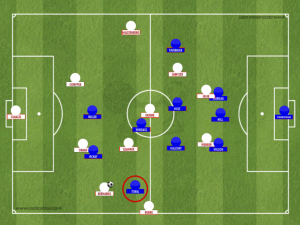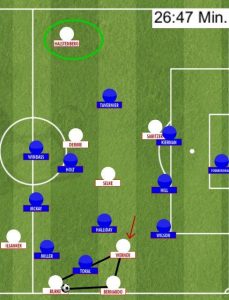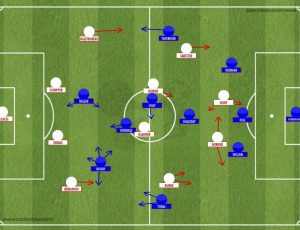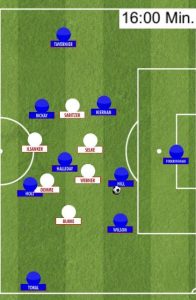Tactical Analysis: RB Leipzig 4-0 Rangers FC
In an intriguing mid-season friendly, Bayern’s closest Bundesliga rivals RaesenBall Leipzig challenged Mark Warburton’s Rangers. In what is supposed to be preparation for inevitable foreign competition in Europe next season, the sides would meet at the Red Bull Arena in a fixture set up to provide an opportunity for experimentation.
Leipzig lined-up in their typical 4-4-2/4-2-2-2 shape which Hassenhutl appears to have drummed into his players as their default shape. Peter Gulacsi was in goals. The back four was Bernardo, Orban, Compper and Halstenberg. Ilsanker and Demme played as a pairing in the centre of midfield, with Oliver Burke on the right facing a team from his home country. Marcel Sabitzer was the inside left. Timo Werner and Davie Selke formed a young German strikeforce.
Rangers continued their attempts at their variation of the 3-5-2 formation. Foderingham was chosen in goals, with Rob Kiernan, Clint Hill and Danny Wilson, the defensive three ahead of him. Tavernier and Toral played as right and left wing-back. Andy Halliday was Rangers deepest midfielder, whilst Jason Holt played as an 8 capable of moving right or left. Josh Windass played as version of 10. Barry McKay played an extremely variable role as a left forward, with Miller selected to partner him as 9.
Targeting the Wings
Identifying the wings as an area where they could exploit and thrive, Leipzig adopted a wing focus. In more than one phase of the game, Leipzig continually based their triggers and play on wing related actions.
In the attacking phase of play, Leipzig used a number of different patterns/movements in a focus on exploiting the weakness of Rangers wings, particularly in deeper areas.
The main weakness of Rangers defensive system was their attacking wing-backs. With Tavernier and Toral playing wing-back roles based primarily ahead of the defensive line, better aligned with the midfield line, there was significant space left behind these wing-backs on both wings. Rangers outer centre-backs Kiernan and Wilson didn’t make lateral shifts to cover this space, as they were required to defend constant Leipzig runners in and around the box.

Kiernan and Wilson remained centrally in order to prevent RBL having overloads in the key attacking space directly in front of the goals.
One pattern RaesenBall commonly used to exploit this large space on the wing was based around a particular combination and timed run.

With Jon Toral, the Rangers LWB, being willing to press very high, and even inside onto receivers in his near halfspace, Bernardo/Oliver Burke were often left free on the wing. RBL fully exploited this by ‘baiting’ him inside to press Ilsanker. When Ilsanker received and Toral moved inside to press, Timo Werner began his blindside movement from behind Halliday into the halfspace. To make this movement from Halliday’s blindside was key, as it meant Werner possessed dynamical superiority, due to Halliday only seeing him in his peripheral vision at the decisive moment of the pass. This should allow him to receive freely in the halfspace with a reduced chance of Halliday intercepting.
As the pass to Werner followed it’s path, breaking Rangers lines in the process, Burke would begin a bursting run up the wing. The reason for a delayed, explosive run was that it provided Rangers with far less of a reaction time, meaning no-one could react quick enough to block/mark Burke. A receiving Timo Werner would then play a ’round-the-corner’ pass to an onrushing Burke. With Demme, Sabitzer and Selke all beginning threatening runs towards the box, Wilson had the tough decision of defending the box and leaving Burke alone to attack the space left on the wing, or leaving position to press him, though risking a Leipzig overload in the key space of the penalty box.
From this pattern, RBL found great success, particularly on the right wing, with Oliver Burke receiving the ball on a free wing (if not free, he usually still possessed positional/spatial superiority, as well dynamic/qualitative due to his strong 1v1 ability) on numerous occasions. The Scottish youngsters actions in these situations were impressive, with his direct running behind paired with some measured cutbacks to Leipzig runners.
Another method RBL used in their wide attacks were drifting movements from Werner onto the wings, again particularly the right. These movements were made with the purpose creating dynamical and numerical superiorities. Starting from central positions, occupying Danny Wilson/Clint Hill, Werner would often make explosive diagonal movements either side of Rangers backline, particularly the right. Using his pace, Leizpig would target long passes into these wide spaces. Werner would then attempt to beat the line with a fast dribble before Rangers had time to shift and defend here.
As well as utilising Werner’s individual attributes of pace and dribbling, his actions which contributed more structurally were also key. Sometimes, rather than making diagonal movements, to take him closer to Rangers goal, Werner would make horizontal movements, which sometimes put him into positions on the right of midfield which Oliver Burke would be accustomed to. When Werner made these movements, Burke would sit slightly deeper on the right wing, allowing Werner to occupy higher up, whilst the ball-near of CM, and FB, more often than not Ilsanker, would move diagonally into the right halfspace. This created a stronger structure on the wing for combations. As well as creating this strong, triangular for combinations, we saw a common positional play concept attempted by RBL once or twice in this friendly, perhaps as experimentation and early implementation, prior to using it in competitive fixtures. Leipzig attempted to overload the right, with Werner-Burke-Bernardo/Ilsanker. By overloading the right, Rangers were forced to adapt situationally and shift to focus on defending the right. This caused an unbalance in Rangers structure, seeing him lose control over the far side.

As this wing became underloaded, Leipzig would look for a switch to Halstenberg/Sabizter, who would ideally be on an open wing, or in a 1v1 situation.
Structurally, RBL actually established effective conditions for this concept to take place, but the limiting factor was as expected the capabilities of those carrying it out. Though Halstenberg was able to make use of attacking situations, his teammates combinational skills, and ability to play an efficient, accurate switch to him weren’t suitable. Though very intriguing to see Hasenhutl attempt such patterns, the profiles required to play in RBL’s model are perhaps unsuitable to such concepts.
The attacking phase of play was not the only one which saw Leipzig target the wings. As always, RBL’s pressing scheme was clear, direct and effective. Using specific triggers, timings, movements and blocks, Leipzig largely dictated the way Rangers phase one would go. Initially sitting in a midblock, which prevented simple Rangers progression through the centre, though lacked intense pressure on the backline, Leipzig wouldn’t show any signs of springing into their high pressure, until triggers occurred, or they directed Rangers. Triggers of a central press included:
– Slow passes
– High passes
– Inaccurate passes
– Backwards passes
– Passes into the centre of Leipzig’s ‘box press’
When any of these triggers occurred, Leipzig would begin pressing with great intensity and increased horizontal compactness in the centre. Though still important to their scheme, this central pressure was not as important as their wide pressure. RBL decided themselves when they would begin their wide pressure. By positioning themselves in a 2-2-2 box formation, with great horizontal compactness, RBL prevented Rangers progressing through the centre, as all vertical passing lanes through here were covered or blocked. This forced Rangers towards their wings, where their outer defenders or wing-backs would receive outside of the RBL block. As this pass to a receiver deep on the wing is made, RaesenBall spring into a diagonal press. Due to the speed of the Leipzig diagonal press, Rangers are unlikely to be able to get a teammate over to support the receiver, as just moments ago, they were attempting to stretch Leipzig, with large distances between each other. This left the receiver isolated, and far easier to press, as his only effective escape method was an almost impossible dribble.
Compactness Issues
Despite RB Leipzig’s great pressing throughout the match, which caused Rangers a massive range of problems in the majority of their possession, there remained issues with the implementation in this game.
With the first two/three lines (2-2-2) often rushing forward to spring into an intense press on Rangers phase one or two, there was an importance for vertical shifts, from all lines, in order to maintain vertical compactness. These shifts had to be quick and almost instant, so there was no space where Leipzig didn’t want there to be, and any escaping Rangers actions could be intercepted before space was exploited. Due to a number of reasons however, RBL’s back four, particularly the CB’s, were unable to step up and maintain a high enough line at the right times.
The vertical stretching movements of Rangers forwards were an important reason why Leipzig’s backline found stepping up at the correct moments difficult. Particularly Kenny Miller, the main 9, though also McKay and Windass, made vertical stretching movements into the space between Leipzig’s defenders and their goal, with good timing. As Rangers CB looked to have a chance of escaping a press, and shaped their body to play a long ball, one of Rangers forward’s would begin a bursting run behind Leipzig’s defensive line. By timing it well and likely remaining onside in the process, this placed a doubt in Leipzig defenders heads over whether stepping up and retaining their high line was the correct decision. When deciding to drop off, the vertical compactness between CB’s and CM’s was reduced greatly, as the CMF’s would be pressing high into Halliday and Holt. In the great space now between these lines, Josh Windass or Barry McKay could normally be found dropping into. Rangers CB’s, if paying attention to such movements, and capable of executing, would find one of the pair between Leizpig’s lines, with a chipped pass over the midfield, or a fast, penetrative pass.
Luckily for RBL, this was not always possible due to Rangers poor execution. On the German’s part however, the loss of vertical compactness between their defensive line and central-midfielders was a worry, and one that could cause them huge problems against opposition of a higher quality.
Conclusion
Though the match was little more than an exhibition used for preparation for the second half of the season, this game was a very interesting one tactically. It should be an encounter both managers evaluate comprehensively, as the flaws for both sides which were shown up are one important for addressing.
Writer: @boxtoboxcb
Photo: Sky Sports



